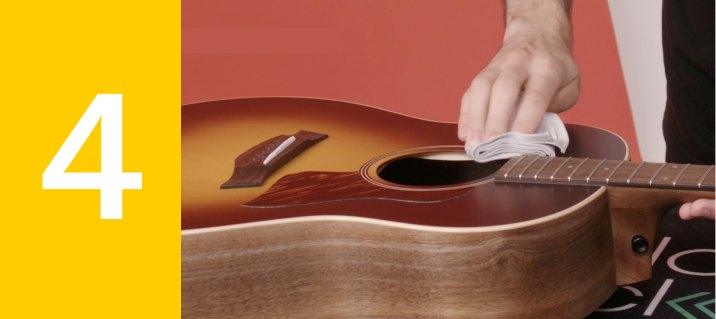How To Restring
An Acoustic Guitar
A step-by-step guide: changing the strings on an acoustic guitar
Step 1: Gather the Necessary Tools and Materials
Step 2: Preparing Your Workspace

1. Find a clean, well-lit area where you can work comfortably.
2. Put down a rolled towel or Universal Neck Rest support to hold up the guitar’s neck and lay down a WYKYK String Change Mat or a soft cloth/towel to protect the guitar's body from scratches or damage – unless you’re going for that relic’d guitar look, then scratch away!
3. Set up a stable surface, such as a table or workbench, to securely hold your guitar.
Step 3: Removing the Old Strings

1. Start by loosening the tension on the old strings. Turn the tuning pegs so that the pitch lowers until the strings are slack.
2. Once the strings are sufficiently loose, cut them at the 12th fret using a Pro-Winder or wire cutters. This will allow you to coil both sides of the string together evenly. Using the bridge pin puller on your Pro-Winder, you can remove the bridge pins from your guitar. Keep them in order as you’ll need them later.
3. Carefully remove the old strings from the tuning pegs, being mindful not to scratch the guitar's surface. Mind the sharp ends and find your nearest PlayBack Guitar String Recycling center.
Step 4: Cleaning and Inspecting the Guitar

1. With all the old strings removed, it’s a great time to clean your guitar. Use a microfiber cloth to wipe down the body, neck, and fretboard.
2. If desired, apply some guitar polish to restore the guitar's shine and protect the finish.
Step 5: Install the New Strings

Open your fresh set of guitar strings and unravel them. Begin with the thickest string (low E) and insert the ball-end into the open bridge pin hole, then secure the string by inserting the appropriate bridge pin and pushing it firmly until it is snug. You can gently pull up on the string while pushing down on the bridge pin to ensure it is seated firmly.
Step 6: Stringing the Guitar

Moving from the thickest to the thinnest string, repeat the process for each string. Drop the ball-end into the bridge pin hole, fully insert the bridge pin, and gently pull on the string so the ball end is properly seated and snugly secured.
Step 7: Wind the Strings

Once all the strings are attached to the bridge, carefully guide each string up to the corresponding tuning peg. Start with the low E string and insert it into the appropriate peg. To determine how much slack you want on the string before winding it, you’ll want to put your palm upright under at the 12th fret and use that to estimate how much excess length you need. Turn the tuning peg counterclockwise to tighten the string, typically the string will rotate away from the logo. For convenience, you can use a string winder to speed up the winding process. Don’t overdo it or your new strings can break.
Step 8: Tune the Guitar

1. With all the strings on, it's time to tune your guitar. Use a guitar tuner to bring each string to its desired pitch. Begin with the low E string and work your way up to the high E string, making sure each string is properly tuned before moving on.
2. Stretch the strings to help them settle and stabilize. Gently pull each string away from the guitar body, being cautious not to pull too hard or too fast. This will relieve any excess slack and improve tuning stability. Once stretched, re-tune each string, as they tend to go slightly out of tune during the stretching process.
Step 9: Knowing When To Change Again

Generally, your guitar and strings will tell you when it is time for new strings. Due to the differences in our body chemistry, local weather, and our sound preferences, some people change strings daily and others once a career! A good bet is once a month or two. If you can hear a significant change in the strings’ sound or are experiencing excessive pitting or other signs of rust on the strings, it is definitely time to change the strings.
Conclusion
Changing the strings on an acoustic guitar will enhance your playing in countless ways. Regular string changes not only improve the sound and playability of your instrument but also help extend its lifespan by giving you time to inspect for incrimental changes. By following this step-by-step guide, you can confidently change the strings on your acoustic guitar, keeping it in prime condition and ready for all your musical adventures.

